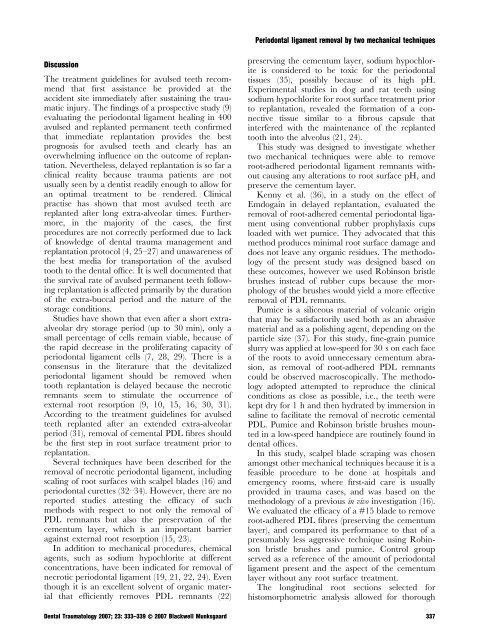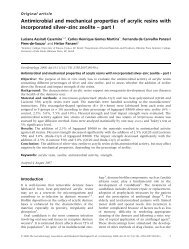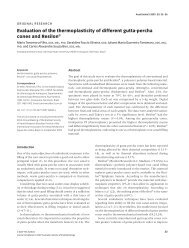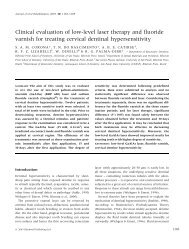Mechanical removal of necrotic periodontal ligament by either ...
Mechanical removal of necrotic periodontal ligament by either ...
Mechanical removal of necrotic periodontal ligament by either ...
You also want an ePaper? Increase the reach of your titles
YUMPU automatically turns print PDFs into web optimized ePapers that Google loves.
Periodontal <strong>ligament</strong> <strong>removal</strong> <strong>by</strong> two mechanical techniques<br />
Discussion<br />
The treatment guidelines for avulsed teeth recommend<br />
that first assistance be provided at the<br />
accident site immediately after sustaining the traumatic<br />
injury. The findings <strong>of</strong> a prospective study (9)<br />
evaluating the <strong>periodontal</strong> <strong>ligament</strong> healing in 400<br />
avulsed and replanted permanent teeth confirmed<br />
that immediate replantation provides the best<br />
prognosis for avulsed teeth and clearly has an<br />
overwhelming influence on the outcome <strong>of</strong> replantation.<br />
Nevertheless, delayed replantation is so far a<br />
clinical reality because trauma patients are not<br />
usually seen <strong>by</strong> a dentist readily enough to allow for<br />
an optimal treatment to be rendered. Clinical<br />
practise has shown that most avulsed teeth are<br />
replanted after long extra-alveolar times. Furthermore,<br />
in the majority <strong>of</strong> the cases, the first<br />
procedures are not correctly performed due to lack<br />
<strong>of</strong> knowledge <strong>of</strong> dental trauma management and<br />
replantation protocol (4, 25–27) and unawareness <strong>of</strong><br />
the best media for transportation <strong>of</strong> the avulsed<br />
tooth to the dental <strong>of</strong>fice. It is well documented that<br />
the survival rate <strong>of</strong> avulsed permanent teeth following<br />
replantation is affected primarily <strong>by</strong> the duration<br />
<strong>of</strong> the extra-buccal period and the nature <strong>of</strong> the<br />
storage conditions.<br />
Studies have shown that even after a short extraalveolar<br />
dry storage period (up to 30 min), only a<br />
small percentage <strong>of</strong> cells remain viable, because <strong>of</strong><br />
the rapid decrease in the proliferating capacity <strong>of</strong><br />
<strong>periodontal</strong> <strong>ligament</strong> cells (7, 28, 29). There is a<br />
consensus in the literature that the devitalized<br />
<strong>periodontal</strong> <strong>ligament</strong> should be removed when<br />
tooth replantation is delayed because the <strong>necrotic</strong><br />
remnants seem to stimulate the occurrence <strong>of</strong><br />
external root resorption (9, 10, 15, 16, 30, 31).<br />
According to the treatment guidelines for avulsed<br />
teeth replanted after an extended extra-alveolar<br />
period (31), <strong>removal</strong> <strong>of</strong> cemental PDL fibres should<br />
be the first step in root surface treatment prior to<br />
replantation.<br />
Several techniques have been described for the<br />
<strong>removal</strong> <strong>of</strong> <strong>necrotic</strong> <strong>periodontal</strong> <strong>ligament</strong>, including<br />
scaling <strong>of</strong> root surfaces with scalpel blades (16) and<br />
<strong>periodontal</strong> curettes (32–34). However, there are no<br />
reported studies attesting the efficacy <strong>of</strong> such<br />
methods with respect to not only the <strong>removal</strong> <strong>of</strong><br />
PDL remnants but also the preservation <strong>of</strong> the<br />
cementum layer, which is an important barrier<br />
against external root resorption (15, 23).<br />
In addition to mechanical procedures, chemical<br />
agents, such as sodium hypochlorite at different<br />
concentrations, have been indicated for <strong>removal</strong> <strong>of</strong><br />
<strong>necrotic</strong> <strong>periodontal</strong> <strong>ligament</strong> (19, 21, 22, 24). Even<br />
though it is an excellent solvent <strong>of</strong> organic material<br />
that efficiently removes PDL remnants (22)<br />
preserving the cementum layer, sodium hypochlorite<br />
is considered to be toxic for the <strong>periodontal</strong><br />
tissues (35), possibly because <strong>of</strong> its high pH.<br />
Experimental studies in dog and rat teeth using<br />
sodium hypochlorite for root surface treatment prior<br />
to replantation, revealed the formation <strong>of</strong> a connective<br />
tissue similar to a fibrous capsule that<br />
interfered with the maintenance <strong>of</strong> the replanted<br />
tooth into the alveolus (21, 24).<br />
This study was designed to investigate whether<br />
two mechanical techniques were able to remove<br />
root-adhered <strong>periodontal</strong> <strong>ligament</strong> remnants without<br />
causing any alterations to root surface pH, and<br />
preserve the cementum layer.<br />
Kenny et al. (36), in a study on the effect <strong>of</strong><br />
Emdogain in delayed replantation, evaluated the<br />
<strong>removal</strong> <strong>of</strong> root-adhered cemental <strong>periodontal</strong> <strong>ligament</strong><br />
using conventional rubber prophylaxis cups<br />
loaded with wet pumice. They advocated that this<br />
method produces minimal root surface damage and<br />
does not leave any organic residues. The methodology<br />
<strong>of</strong> the present study was designed based on<br />
these outcomes, however we used Robinson bristle<br />
brushes instead <strong>of</strong> rubber cups because the morphology<br />
<strong>of</strong> the brushes would yield a more effective<br />
<strong>removal</strong> <strong>of</strong> PDL remnants.<br />
Pumice is a siliceous material <strong>of</strong> volcanic origin<br />
that may be satisfactorily used both as an abrasive<br />
material and as a polishing agent, depending on the<br />
particle size (37). For this study, fine-grain pumice<br />
slurry was applied at low-speed for 30 s on each face<br />
<strong>of</strong> the roots to avoid unnecessary cementum abrasion,<br />
as <strong>removal</strong> <strong>of</strong> root-adhered PDL remnants<br />
could be observed macroscopically. The methodology<br />
adopted attempted to reproduce the clinical<br />
conditions as close as possible, i.e., the teeth were<br />
kept dry for 1 h and then hydrated <strong>by</strong> immersion in<br />
saline to facilitate the <strong>removal</strong> <strong>of</strong> <strong>necrotic</strong> cemental<br />
PDL. Pumice and Robinson bristle brushes mounted<br />
in a low-speed handpiece are routinely found in<br />
dental <strong>of</strong>fices.<br />
In this study, scalpel blade scraping was chosen<br />
amongst other mechanical techniques because it is a<br />
feasible procedure to be done at hospitals and<br />
emergency rooms, where first-aid care is usually<br />
provided in trauma cases, and was based on the<br />
methodology <strong>of</strong> a previous in vivo investigation (16).<br />
We evaluated the efficacy <strong>of</strong> a #15 blade to remove<br />
root-adhered PDL fibres (preserving the cementum<br />
layer), and compared its performance to that <strong>of</strong> a<br />
presumably less aggressive technique using Robinson<br />
bristle brushes and pumice. Control group<br />
served as a reference <strong>of</strong> the amount <strong>of</strong> <strong>periodontal</strong><br />
<strong>ligament</strong> present and the aspect <strong>of</strong> the cementum<br />
layer without any root surface treatment.<br />
The longitudinal root sections selected for<br />
histomorphometric analysis allowed for thorough<br />
Dental Traumatology 2007; 23: 333–339 Ó 2007 Blackwell Munksgaard 337






